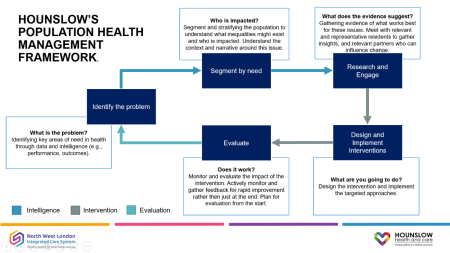The Hounslow Public Health Team were concerned that cancer screening rates for bowel, breast and Cervical cancer may be below the England average.
The team implemented the Population Health Management Framework to help identify any areas of concern.

Data evidenced:
• Cervical screening rates for Hounslow residents had decreased over the past 10 years.
• Cervical screening rates were lower than the England average, and lower than many London boroughs, and far below the acceptable threshold of 80%.
• Cervical screening rates for Hounslow residents aged 25-49 were lower than residents aged 50-64.
• Large uptake variations between GP practices in the borough
• Majority of lower uptakes were in Hounslow Health and Great West Road Primary Care Networks(PCNs).
Impacted Group:
25–49-year-olds in two PCNs
• Hounslow Health PCN (59.7% uptake, March 2022)
• Great West Road PCN (56.5% uptake, March 2022)
(The national target uptake is 80%).
What did the Research highlight
PHMF was used as a tool to consider the uptake rates of screening for breast, bowel and cervical screening (which form the national cancer screening programme). Working through the framework enabled the team to be more methodical with the data and insights they already had; identify where more information was required; identify the priority areas. In this case, cervical cancer uptake rates in 25-49yrs in two PCNs
The team used Fingertips data down to GP practice level data regarding the uptake of screening invitations.
Desktop research suggested the below barriers were preventing women from following-up on their screening invitations:

This research helped highlight correlations to the 52.4% BAME population in Hounslow.
New Intervention
To develop a new engagement approach of working with ‘primarily used female close contact businesses’ in two specific localities where data evidenced cervical screening uptake needed to increase women aged 25-49 years.
Within the two localities, the team engaged with ‘71 close contact businesses, such as:
- Nail salons
- Hairdressers.
Carrying out initial engagement, explaining the issue, and why their business was well placed to act as an amplifier for cervical cancer uptake messaging. Businesses were asked if they would be willing to participate, and what they needed to facilitate this (e.g. information on cervical cancer, barriers to screening, what screening entails, myth busting, and what types of resources they felt they would need e.g. Wallet cards, posters, flyers).
Initial engagement had mixed responses, with 27 businesses initially signing up, 11 declined, and 22 who needed to be revisited because owner/manager was not present.
New resources were designed using feedback from businesses and distributed to the 27 which had agreed to participate.
Evaluation
Currently no direct data link to screening uptakes, as other initiatives (a national campaign, screening improvement activities at GP level) are also taking place.
Instead, qualitative data is proving more useful e.g., the businesses’ experience, what clients had to say about screening, whether the information was enough to change clients’ attitudes to having a smear test etc.
The project is still in its infancy stages; however, a two-month interim evaluation has begun with the 27 businesses who initially agreed to support, findings highlighted:
12 businesses are still highly engaged, reporting an average of 2 to 3 conversations a day with members of the public, and all have reported they are comfortable having conversations with their clients either because:
• It’s a relatable topic.
• They're all women.
• They have a strong friendship with their clients.
These businesses prefer to distribute wallet card resources as they fit in a purse etc, and they are easy to store/use than other materials such as leaflets/posters. They have also expressed enthusiasm to engage with future health campaigns.
The remaining 15 businesses require additional support or have now declined involvement.
The Public Health Improvement Service is focusing on qualitative learning, and business relationship building to support future campaigns.